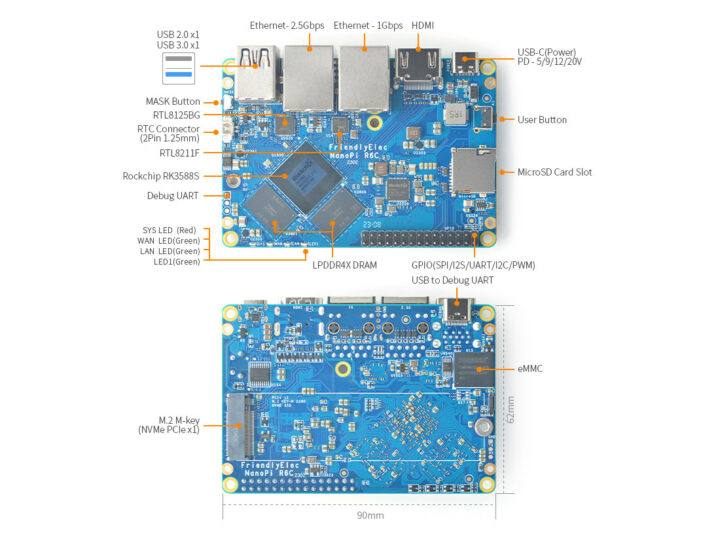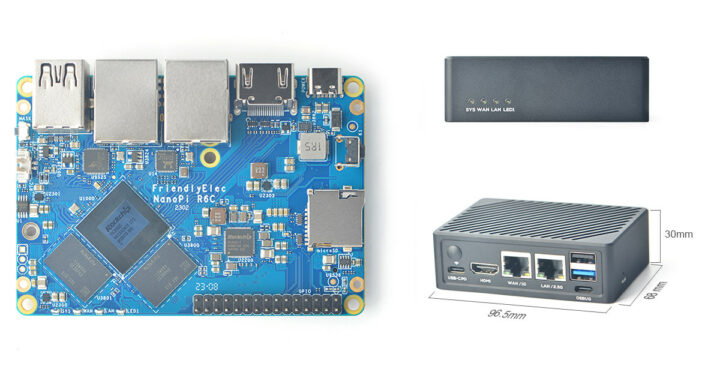FriendlyElec has come up with a low-cost version of the NanoPi R6S with the NanoPi R6C router/SBC based on the same Rockchip RK3588S octa-core Cortex-A76/A55 processor but offering just one Gigabit Ethernet port and one 2.5GbE port, and adding an M.2 NVMe SSD socket for storage.
The NanoPi R6C is also offered with 4GB or 8GB RAM, an optional 32GB eMMC flash soldered on the board, a Micro SD card socket, an 8K capable HDMI 2.1, USB 3.0 and USB 2.0 ports, and a few extra features we’ll discuss further below.
- SoC – Rockchip RK3588S octa-core processor with:
- CPU – 4x Cortex-A76 cores @ up to 2.4 GHz, four Cortex-A55 cores @ 1.8 GHz
- GPU – Arm Mali-G610 MP4 quad-core GPU with OpenGL ES3.2 / OpenCL 2.2 / Vulkan1.1 support
- VPU – 8Kp60 H.265/VP9/AVS2 video decoder, 8Kp30 H.264 decoder, 4Kp60 AV1 decoder, 8Kp30 H.265/H.264 video encoder
- AI accelerator – 6 TOPS NPU
- System Memory – 4GB or 8GB LPDDR4X @ 2133 MHz
- Storage
- MicroSD card socket up to SDR104 mode
- M.2 PCIe 2.1 x1 socket for NVMe 2280 SSD
- Optional 32 GB eMMC flash (HS400 mode)
- Video Output – 1x HDMI 2.1 port up to 8Kp60, or 4Kp120
- Networking
- 1x 2.5GbE RJ45 port via Realtek RTL8125BG PCIe controller tested up to 2.35 Gbps (Rx) and 2.35 Gbps (Tx)
- 1x Gigabit Ethernet RJ45 port via Realtek RTL8211F tested up to 941 Mbps (Tx and Rx)
- USB – 1x USB 3.0 port, 1x USB 2.0 port
- Expansion – 30-pin 2.54mm header connector up to 1x SPI, 3x UARTs, 3x I2Cs, 2x SPDIFs, 1x I2Ss, 3x PWMs, 1x CAN, 20x GPIOs
- Debugging – 3-pin UART header and USB-C Debug UART port with CH341 chip
- Misc
- Mask key for eMMC flash update
- 2-Pin 1.27/1.25mm RTC battery input connector for low-power RTC IC HYM8563TS
- 1x user button
- 4x user-programmable LEDs (SYS, WAN, LAN, LED1)
- Power Supply – 5V/9V/12V/20V USB Type-C port (USB PD support)
- Dimensions – PCB: 90 x 62 mm; enclosure: 96.5 x 68 x 30 mm
- Weight – TBD
- Temperature Range – 0 to 70
 I wish FriendlyElec could have made a dual 2.5GbE router with an M.2 NVMe socket, but that’s not possible with the Rockchip RK3588S processor, and the second 2.5GbE port found in R6S is the casualty of having support for an M.2 PCIe SSD. Other changes include more I/Os with a 30-pin header replacing the 12-pin GPIO header on the NanoPi R6S, and some will be happy to find a USB-C to UART port for easy access to the serial console without having to open or hardware-hack the router to add an external serial interface.
I wish FriendlyElec could have made a dual 2.5GbE router with an M.2 NVMe socket, but that’s not possible with the Rockchip RK3588S processor, and the second 2.5GbE port found in R6S is the casualty of having support for an M.2 PCIe SSD. Other changes include more I/Os with a 30-pin header replacing the 12-pin GPIO header on the NanoPi R6S, and some will be happy to find a USB-C to UART port for easy access to the serial console without having to open or hardware-hack the router to add an external serial interface.
Software support will be the same as for the NanoPi R6S router with OpenWrt-based FriendlyWrt, Android, Debian, and Ubuntu images provided along with detailed documentation in the Wiki. My experience with the NanoPi R6S router was overall positive both with FriendlyWrt 22.03 and Ubuntu 22.04, after some difficulties unrelated to FriendlyElec installing the latter, but I noted some improvements may be needed for video playback in Linux. The power consumption of the R6S was fairly high at idle, and that’s something I’ll check when reviewing the NanoPi R6C router as well.
One way FriendlyElec lowers the cost of the NanoPi R6C is to offer it as a barebone SBC with 4GB RAM and no storage for $85 plus shipping. If you want a complete system with 8GB RAM, 32GB flash, and a metal enclosure, the price goes up to $125, or $14 less than the equivalent NanoPi R6S router.

Jean-Luc started CNX Software in 2010 as a part-time endeavor, before quitting his job as a software engineering manager, and starting to write daily news, and reviews full time later in 2011.
Support CNX Software! Donate via cryptocurrencies, become a Patron on Patreon, or purchase goods on Amazon or Aliexpress






@willy – you wish has been granted:
USB-C Debug UART port with CH341 chip
The gods have listened, rejoyce ! 😀
I actually found a fairly neat solution to the missing external debug port – add a bluetooth module to the usual 4-pin header. I used a JDY-31 module, which cost under $1 from Aliexpress, and can be connected to at 115200 baud. You can also reprogram the advertised name, which is convenient if you have multiple devices, and of course, choose your own PIN.
The only “not quite so nice” part is the inline control signalling, when connecting and disconnecting, which ends up hitting the shell if you left it logged in (or don’t require login), or else confuses the getty process a bit.
Ideally, I’d love to see a mashup of bootterm and sslh, that monitors the bluetooth connected state, and when a new connection comes in, checks for the ssh handshake, and if found, opens a TCP socket to localhost:22 (by default, or something else by configuration), otherwise invokes the usual tty login or shell process. And of course, monitors passing traffic through the connection for the DISCONNECTED messages to terminate either the forwarded TCP connection, or the shell.
Of course, by mashup, I mean the serial port handling of bootterm, and the protocol detection and routing of sslh. Not that I expect to use SSL over bluetooth, but SSH over bluetooth/serial console would be pretty neat! Apart from the improved authentication, and encryption of “over the air” traffic, the connection multiplexing should be useful.
One other thing about the BT console is that it tends to survive reboots, so you can get into U-Boot if you need to. I says “tends to”, because I have only tested it on one device, so have no real data on the Vcc pin behaviour in general.
Of course, it doesn’t help get early logs from a cold boot, because the dongle is also powered off, and there is a gap while you associate with it where messages will go missing, and opportunities to interrupt U-Boot are missed. But if you can reboot after association, everything just worked in my testing.
Except many of the NanoPi devices only have 3-pins available for UART.
Yeah, that can be a problem. I guess Vcc can be sourced elsewhere on the board, but not as cleanly.
Here’s the Mastodon thread that I posted about it:
https://infosec.exchange/@RoganDawes/109944170966015025
Alleluiah, a console port! Finally! THANK YOU FriendlyELEC !
I often wondered why FriendlyELEC’s first router based SBC the NanoPi R1 had the UART exposed, but all the following ones did not.
What’s so great about that chip?
Most probably nothing other than the chip already being soldered to the PCB and accessible via a separate USB-C socket?
If we are writing wishlists, I wish manufacturers of these little travel routers would include USB gadget support, which would allow for e.g. an extra network interface towards the PC powering it, over the same cable, and/or a USB-Serial console, USB network firmware recovery feature, etc.
Makes me sad when the hardware has OTG support, but it is ignored.
> Makes me sad when the hardware has OTG support, but it is ignored.
Have you checked schematics or what lets you believe OTG / gadget mode wouldn’t work?
I would be more concerned about powering the thing from a laptop/PC since currently this doesn’t work with my Rock 5B (which uses similar/same components as R6C for powering: FUSB302 and MP8759)
I meant it as a generic complaint, not specifically targeted at this device.
And yes, powering the more recent devices from a USB port is not always a great idea!
> powering the more recent devices from a USB port is not always a great idea!
But funnily those recent devices are in fact designed to be powered that way. RK devices (almost) all use the FUSB302 + MP8759 combo to cope with USB PD (the full 5V-20V spectrum) and a Computer’s USB-C port that should comply to TB3/USB4 specs has to provide 15W (5V at the max 3A) on one and 7.5W on further USB-C ports.
So all it needs now is mainline kernel support because that wonky old ass BSP Kernel is in no way appropriate to be someone’s gateway.
One would except 2x 2.5Gbit if they call it a 2.5GbE router.
> if they call it a 2.5GbE router
Jean-Luc does, ‘they’ don’t. FriendlyELEC calls it an ‘open-sourced mini IoT gateway device’.
Same with new R5C though that one is even equipped with two 2.5GbE ports since based on RK3568 and not the castrated RK3588s here.
Also they definitely needed to remove certain things to justify a lower price.
By the way one annoying thing with 2.5G controllers is that dual-port ones are almost non-existent. The only one I found is intel v710-AT2, at $75/pc for 22mm*22mm, it definitely doesn’t qualify for such products. I’m pretty sure that vendors would easily adopt a dual-port controller if it was cheap enough. Even at PCIe x1 gen2 it will be OK since most of the time a dual-port device will use its two ports in opposite directions.
> The only one I found is intel v710-AT2, at $75/pc for 22mm*22mm
Well, there’s a reason most dual 2.5GbE NICs slap a PCIe switch and two RTL8125BG on the PCB:
https://luckyretail.com/Uploadfile/20222/081/202208152/I500294837/I500294837-2f.jpg
No analog audio ? :'(